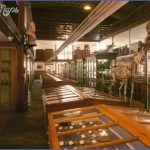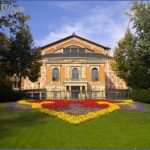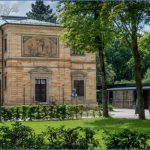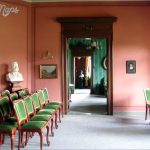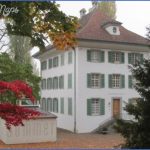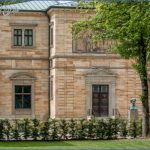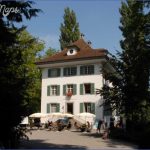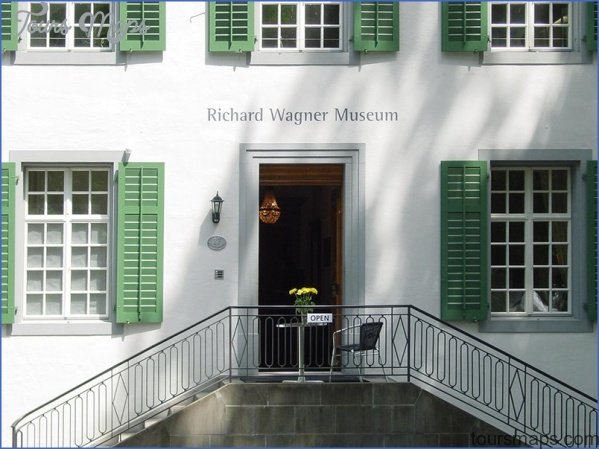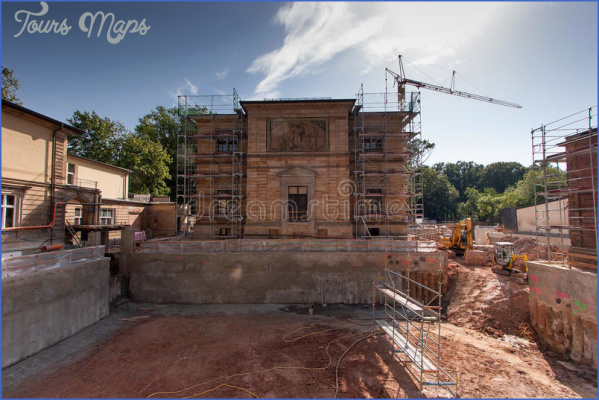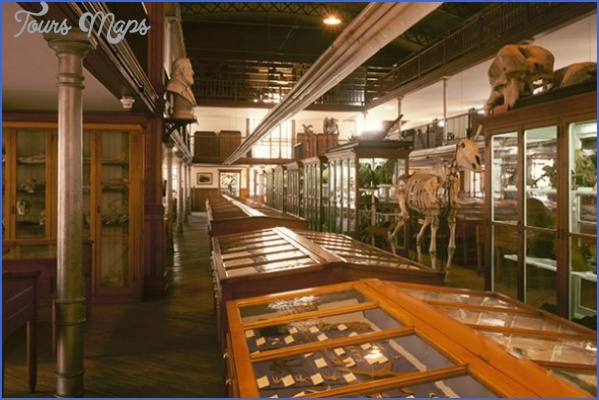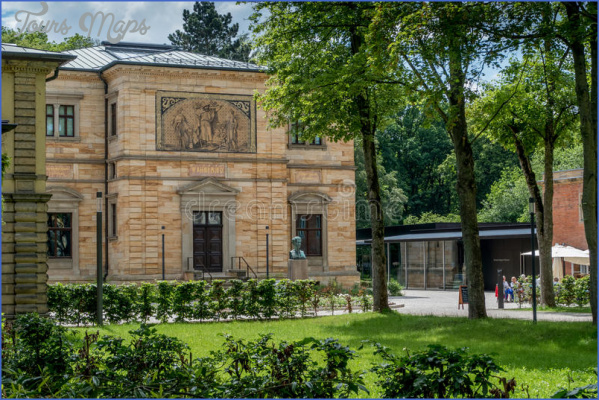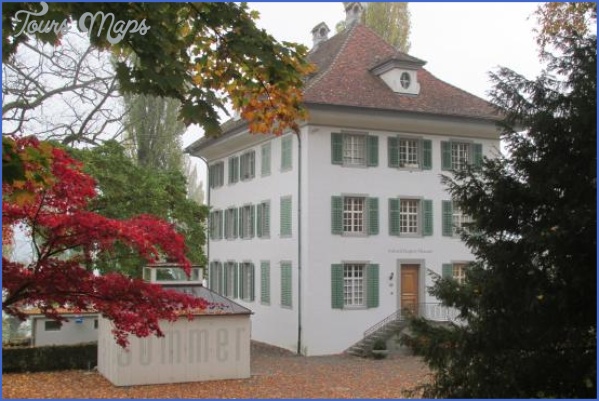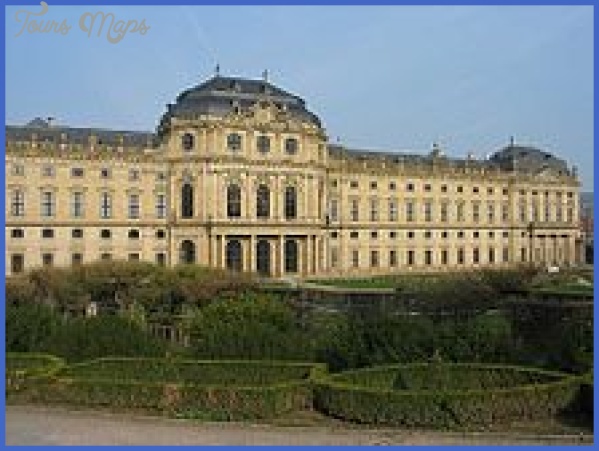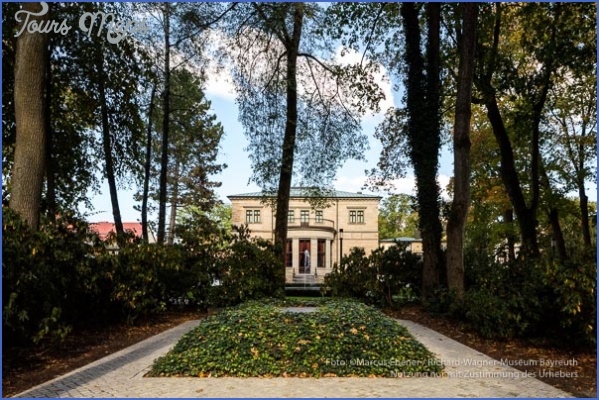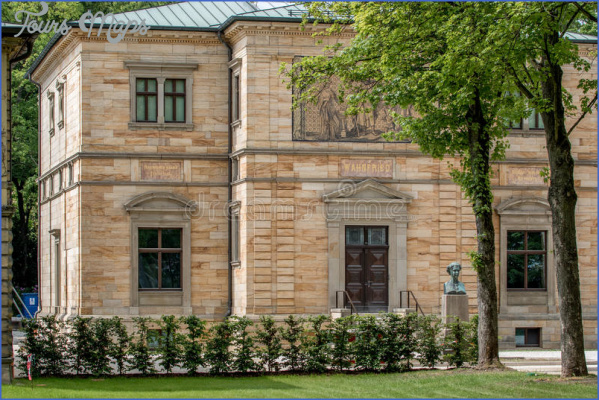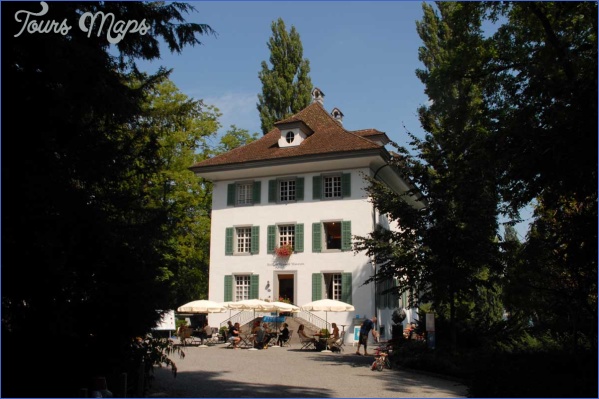WAGNER MUSEUM
Not many composers have the opportunity to establish their own museum: but Richard Wagner was exceptional in many ways. The grandest of the memorials to the great man, perhaps the grandest of all composer museums, if not the most commodious, is of course the house that he himself built in Bayreuth – at Ludwig II’s expense – although the museum was not established there until 1976. There are two other substantial Wagner museums, also in places strongly associated with his adventurous life, and a further one associated with his death.
The oldest Wagner museum in Germany, however, is another, rather smaller institution, in a town, Eisenach, that is visited more often by Bach pilgrims than Wagner ones. There, aptly placed at the foot of the Wartburg, with its national symbolic significance, below the castle whose ancient halls of song were immortalized by Wagner in Tannhauser – in fact he first visited the site only in 1849, four years after the opera’s premiere – stands the Reuter-Wagner Museum. The poet Fritz Reuter built his neo-Renaissance villa there in 1866-8. He died in 1874, and his widow in 1894; it was then bought by the city of Eisenach and set up as a museum to him. In 1895, the large Wagner collection of the Austrian Nicolaus Oesterlein, which had originally been exhibited in a private museum in Vienna, was acquired and incorporated.
The collection is based on a large library, which contains some 6000 volumes and 200 letters. Among the display material are facsimiles of music and programmes, maquettes of opera scenes, busts and death masks (of Liszt as well as Wagner). There is also a manuscript score of the Rienzi overture.
There is no museum to Wagner in Leipzig, where on 22 May 1813 he was born (the house, in Bruhl, was demolished in 1896; there is a plaque on the site). As a child of nine he moved to Dresden, to enter the Kreuzschule, and he remained there when the family moved to Prague. His career took him to Magdeburg, Konigsberg, Riga and Paris, and then back to Dresden, in 1842, where Rienzi was to be given. The following year he was appointed joint Kapellmeister to the Dresden court. The Saxon capital remained his home until 1849, when his political activities forced him into exile. He lived near the centre of the city, but in May 1846 he and his first wife Minna went to stay for just over two months in a first-floor apartment in a house in Grofi-Graupa, between Pillnitz and Pirna: this is now the suburb of Graupa. There he worked on the sketches for Lohengrin, and met for the first time Hans von Bulow, then only 16, whose life was later to intersect with his.
The house where he lived became a museum to him in 1907, but its existence was at first sporadic; it was reopened in 1951, and extensively modernized in 1982, with the theme ‘Richard Wagner and Dresden’. On the ground floor there
WAGNER MUSEUM Photo Gallery
Wagner museum at Graupa is a recital room, with a mini-barrel-vaulted ceiling, seating over 100, used also for art exhibitions; next to it is a display room, dealing with Wagner’s later, revolutionary years in Dresden and the beginning of his exile in Switzerland – there is his poem to the people of Vienna and his documents about theatre reform – as well as theatre drawings by Gottfried Semper and material on his new circle of friends in Zurich and the Wagner Festival held there in 1853. There are also some instruments from the Hofkapelle, including a basset-horn and a serpent. But the main part of the display is on the first floor, in the rooms where Wagner and his wife had actually lived. On the upper landing, Wagner’s ‘Musiksalon’, there is an 18th-century table piano, an oil portrait of Wagner and several facsimiles, including Lohengrin material and portraits of Dresden opera composers (Weber and Marschner, and again Wagner). The first room offers a varied series of images to do with Wagner’s Dresden years: singers, composers and theatre artists associated with the Hoftheater, original handbills, librettos and costume designs, and also a watercolour of a nearby valley that Wagner visited. The second room, Wagner and Minna’s bedroom, houses eight display cases with a rich selection of originals of Wagner letters (and one each from Liszt and Berlioz), along with facsimiles -there is much material relating to the tenor Joseph Tichatschek, the original Rienzi and Tannhauser, to Wagner’s doctor Anton Pusinelli and to the return of Weber’s remains to Germany, as well as librettos, portraits, caricatures and journal articles. A further room is known as the Wagner-Rockel-Raum, after his assistant and political collaborator Karl August Rockel: here and in the passage are a further ten display cases, as well as generously hung walls and glazed tables. The main themes are Wagner’s manuscripts, the continuing history of the Dresden opera, Rockel himself and Wagner’s wider circle of friends, and members of the Dresden governing community. There is a Wagner portrait of 1910 and a plaster bust. The actual furniture is of the period, but not Wagner’s own: there is in fact a photo, from Bayreuth, of the desk he used at Graupa.
When Wagner had to flee Dresden, he went first to Weimar, where he was sheltered by Liszt, and then to Switzerland. Excluded from Germany until 1860, he spent time in Zurich, Paris and briefly Venice; then in the early 1860s he was in Vienna, which he had to flee to escape his creditors, and Munich. It was in 1866 that he and Cosima – Liszt’s daughter, Bulow’s wife – visited Lucerne (Wagner had been there several times, first in 1850, and in 1859 completed Tristan at a hotel there), saw the house called Tribschen, on a promontory overlooking the lake, and decided that this beautiful place should be their eventual home. He moved there that year. Cosima often visited Tribschen but was able to join him there only after the break with Bulow in 1868; they lived there until 1872. Siegfried Idyll, written to celebrate their marriage later that year, the birth of their second child, Siegfried, the previous summer, and her birthday, 24 December, had its first performance on the staircase, with Hans Richter playing the trumpet; Cosima heard it as she lay in bed on Christmas morning.
Tribschen from Lake Lucerne
The autograph score is now displayed in Haus Tribschen. The house, probably of medieval origins, took its present form in 1800. It was acquired in 1931 by the Lucerne municipality and became a Wagner museum in 1933, sharing the premises with the town’s instrument collection, which is housed on the first floor. Downstairs, there are four rooms, elegantly presented in a decorative style of the period of the Wagners’ residence. The first, originally Wagner’s bedroom, contains a number of lithographs (of Tribschen, of Liszt, Wagner himself and Richter) and a charcoal drawing of Mathilde Wesendonck (an important inspiration for Isolde), along with a Wagner family tree. Wagner’s own green-velvet easy chair, now normally the preserve of the resident cat, is in the second room (the green study or Meistersinger room), along with a plaster cast of his right hand, a chronological array of his signatures and various letters and family documents (including their children’s birth certificates), and there are several likenesses of Wagner and Cosima in the display cases, one of which contains the actual clothes he was wearing when he was perched in the velvet chair – as seen in the photograph reproduced on the wall close by (see p.41).
The Idyll autograph is in the third room (the former salon), as, in facsimile, are those of three operas with strong links to Tribschen, Tristan, Die Meistersinger and Siegfried. There are family photos, original pastels of Cosima and Mathilde, several oils including two of Wagner and the Erard grand piano given to him by the maker. The former library has, besides books, busts of Wagner, Cosima and Mathilde and items recalling the visits to Tribschen of Nietzsche and King Ludwig II of Bavaria, among others. Lastly, in the diningroom, are the Renoir lithograph of Wagner, and a central display of autographs, from Meistersinger and Der fliegende Hollander, with proof sheets, a series of postcard pictures of Wagner’s singers, paintings of opera scenes (by
Stassen of Tristan and Thoma of the Ring) and a collection of commemorative stamps. Outside there is a small stone building, hexagonal in shape, in which Wagner kept peacocks, named Wotan and Fricka.
But of course the giant among Wagner museums is Haus Wahnfried itself. The Wagners first considered Bayreuth as their possible base in 1871, and quickly fixed on sites for the Festspielhaus and their own home. The latter does seem to have been chosen with a view not only to comfort and convenience but also to posterity, indeed museum-cum-mausoleum, for Wagner, Cosima and their dog are buried in the back garden. An ‘average, decent-sized dwelling’, Wagner called it in a letter to Ludwig, but here as elsewhere his ideas on what is decent might seem to differ from other people’s.
In 1874 Wagner moved in. The front of the house bears plaques proclaiming ‘Hier, wo mein Wahnen Frieden fand . . . Wahnfried . . . sei dieses Haus von mir benannt’ (‘Here, where my delusions found peace, let this house be named by me “Peace from Delusion”’). After his death (in 1883) the house continued to be the family home. In 1945 it was severely damaged at the rear by a bomb. Wieland Wagner, the composer’s grandson, supervised the immediate repairs, but it was not until 1973, when the house was handed over to the city of Bayreuth by Winifred Wagner (Siegfried Wagner’s English widow) and Wieland, that it could be fully restored; at the same time the neighbouring building, the Siegfried-Wagner-Haus, was bought from Winifred. That building is now the headquarters of the Richard-Wagner-Stiftung and houses the museum administration (for the nearby LISZT museum too) and a fine, comprehensive Wagner library, including virtually all his surviving autograph material, with reading rooms and a multimedia centre. The Stiftung also owns the contents of Haus Wahnfried. Much of the display and archival material had formerly been in the Richard-Wagner-Gedenkstatte in
Haus Wahnfried, Bayreuth Wahnfried, rear elevation, with the graves in the foreground Wahnfried: plaque on the front elevation, left the Neues Schlofi in Bayreuth, which was closed in 1975. The new museum in Haus Wahnfried was opened in 1976, on the anniversary of the complete premiere of Der Ring des Nibelungen. The reconstruction of the 1970s, under the supervision of Wolfgang Wagner, involved not only the repair of damage and the ravages of time, but also the finding of a compromise between restoration of the house’s original form and its adaptation as an effective museum. Central to the design, quite literally, are the two large presentation rooms: the hall by the main entrance, a lofty room the full height of the building, galleried at mezzanine level; and the rear drawing-room, looking out to the garden, which is used for concerts, broadcasts and lectures. Along either side there are display rooms: on the ground floor the front Wahnfried: plaque on the front elevation, right rooms – originally Cosima’s salon and the dining-room – are reserved for special exhibitions, and one at the rear has a ‘Monstrosities and Curiosities’ display, a welcome corrective to any suspicion that Bayreuth might take itself and Wagner too seriously. The basement, darkened, is devoted to well-lit maquettes and photos of stage sets and costumes at and around Bayreuth, chronologically organized, providing an up-to-date visual history of Wagner production.
The main displays are on the upper floors. On the left side of the building there is what is essentially a visual biography of Wagner, arranged to minimize the distances the visitor has to walk (five staircases connect the upper floors) – it begins on the top floor (in Siegfried’s bedroom) with his childhood and early career, then to one of the girls’ rooms for the Paris years, descending to the mezzanine for rooms given over to Dresden and Vienna, then ascending again for the Munich, Lucerne and Bayreuth periods and his death in Venice. A comparable excursion on the right provides a history of the Bayreuth Festival since Wagner’s time, starting at the rear in Cosima’s boudoir, moving into the couple’s bedroom for the era of Tietjen and Preetorius, down to the mezzanine for the grandsons’ productions and ending in Wagner’s study with the most recent ones. Programmes, writings, photos (of singers, friends, lovers, buildings), music or text autographs (or facsimiles), set and costume designs, letters, diaries and other documents: these and much more fill the 68 display cases and the walls in the biographical rooms, each of which is coloured to reflect the character of Wagner’s experience of each phase of his life. One exhibit is the sofa on which Wagner died, in Cosima’s embrace, its fabric now plucked bare by the depredations of relic hunters, anxious to possess a tuft that may have been in contact with the dying master. That sofa was brought to Bayreuth – as too, indeed, was Wagner’s body – from Venice. Wagner had stayed there in 1858-9, at the Palazzo Giustiniano, while completing the scoring of Tristan. In September 1882 he went there with his family and negotiated a lease for three years, with a further two-year option, for an apartment on the mezzanine floor of the Ca’ Vendramin Calergi. This Renaissance palace on the Grand Canal, built by Mauro Codussi and then owned by the Duchess of Berry, was acquired by the city in 1949 and serves in the winter as the municipal casino. In 1995 the ‘Sala Wagner, the room of his death, was entrusted to the Associazione Richard Wagner di Venezia, which opened it to the public as a memorial to the composer. The longer-term intention is to create a larger museum using more of the 28 rooms of Wagner’s apartment – he apparently was travelling with something of an entourage. Wagner died on 13 February 1883. That morning he and Cosima had a violent altercation, over a planned visit by Carrie Pringle, an English girl who had sung one of the flower maidens in Parsifal and with whom Wagner seemingly had (or contemplated) a close relationship. In the afternoon he had a severe heart attack. The room has display cases, one commemorating the first Ring in Venice, shortly after his death, with various documents (police permission, lists of expenses and ticket sales) and posters, one with correspondence and a death mask. There are two large cases with facsimiles of his autograph scores, and photos from Wagner’s time of his favourite places. In the Sala Wagner and in adjoining rooms some of the furniture, belonging to the building, is original, including red damask sofas. The Sala has a delicately sculpted ceiling and a typically Venetian terrace-style floor. The apartment has a direct, external staircase to the garden, which Wagner used, and to the canal, so that he could take a gondola – as indeed he did for his final journey.
There are two plaques on the Ca’ Vendramin, one by the canal, one by the gardens, commemorating Wagner’s death there; there is also a bust in the public gardens by the waterside beyond St Mark’s and the Palazzo Ducale. Wagner memorials abound across Europe. There is one in Paris, erected by the ‘Amis de Richard Wagner’, on 14 Rue Jacob, where he lived in 1841-2. One in Palermo marks his visit to the amphitheatre in
Maybe You Like Them Too
- Explore Doncaster, United Kingdom with this detailed map
- Explore Arroyito, Argentina with this Detailed Map
- Explore Belin, Romania with this detailed map
- Explore Almudévar, Spain with this detailed map
- Explore Aguarón, Spain with this detailed map



